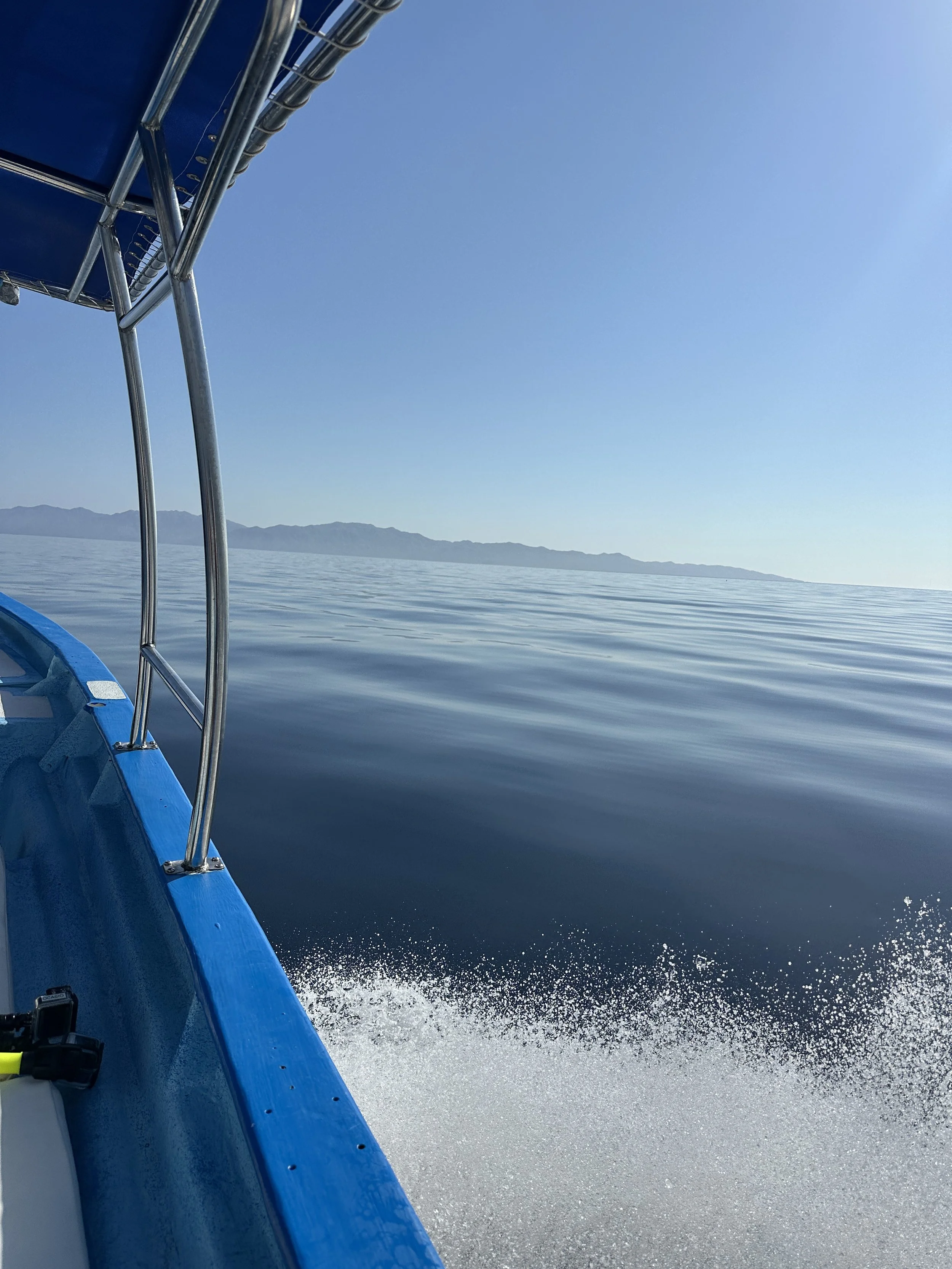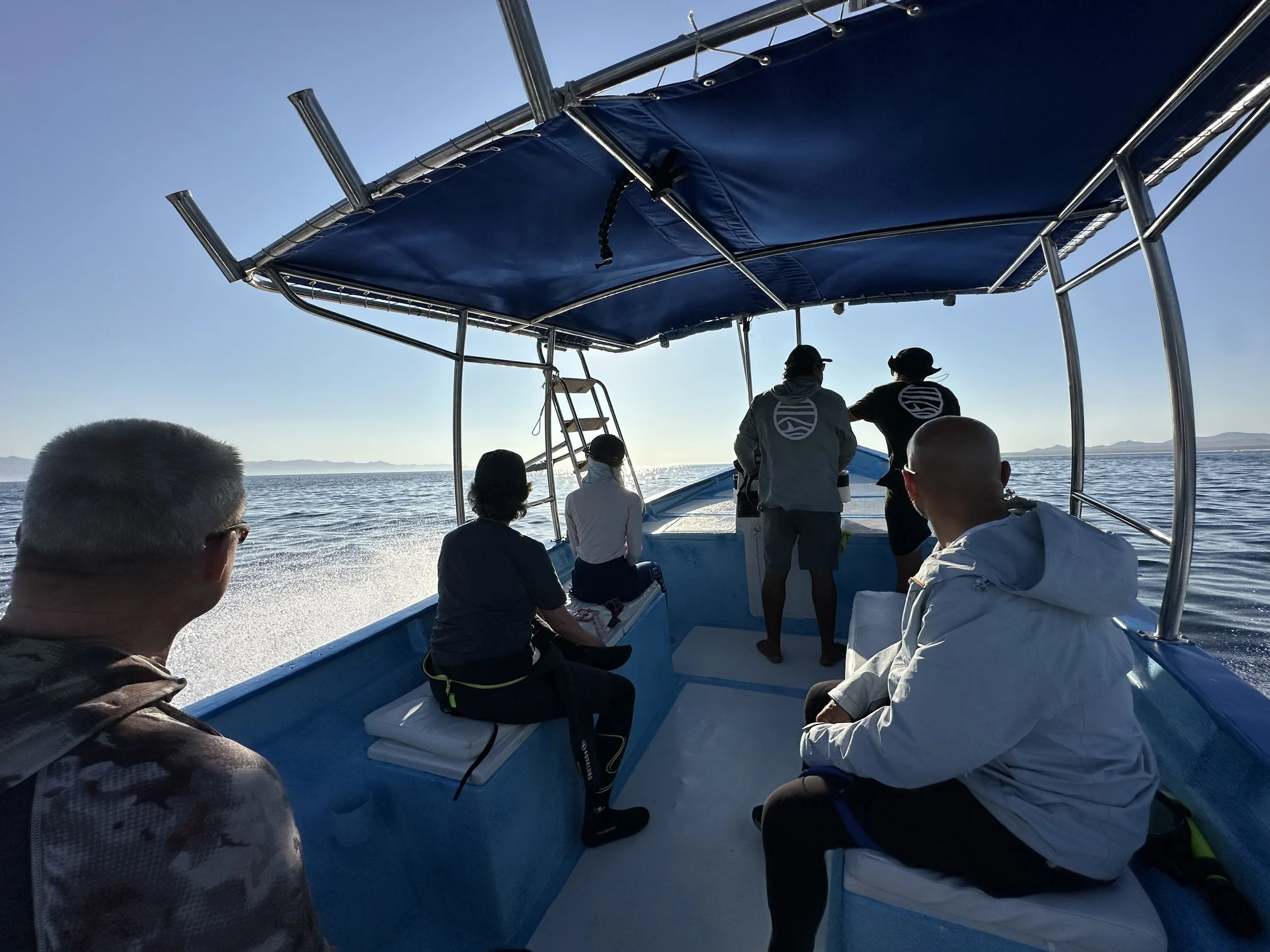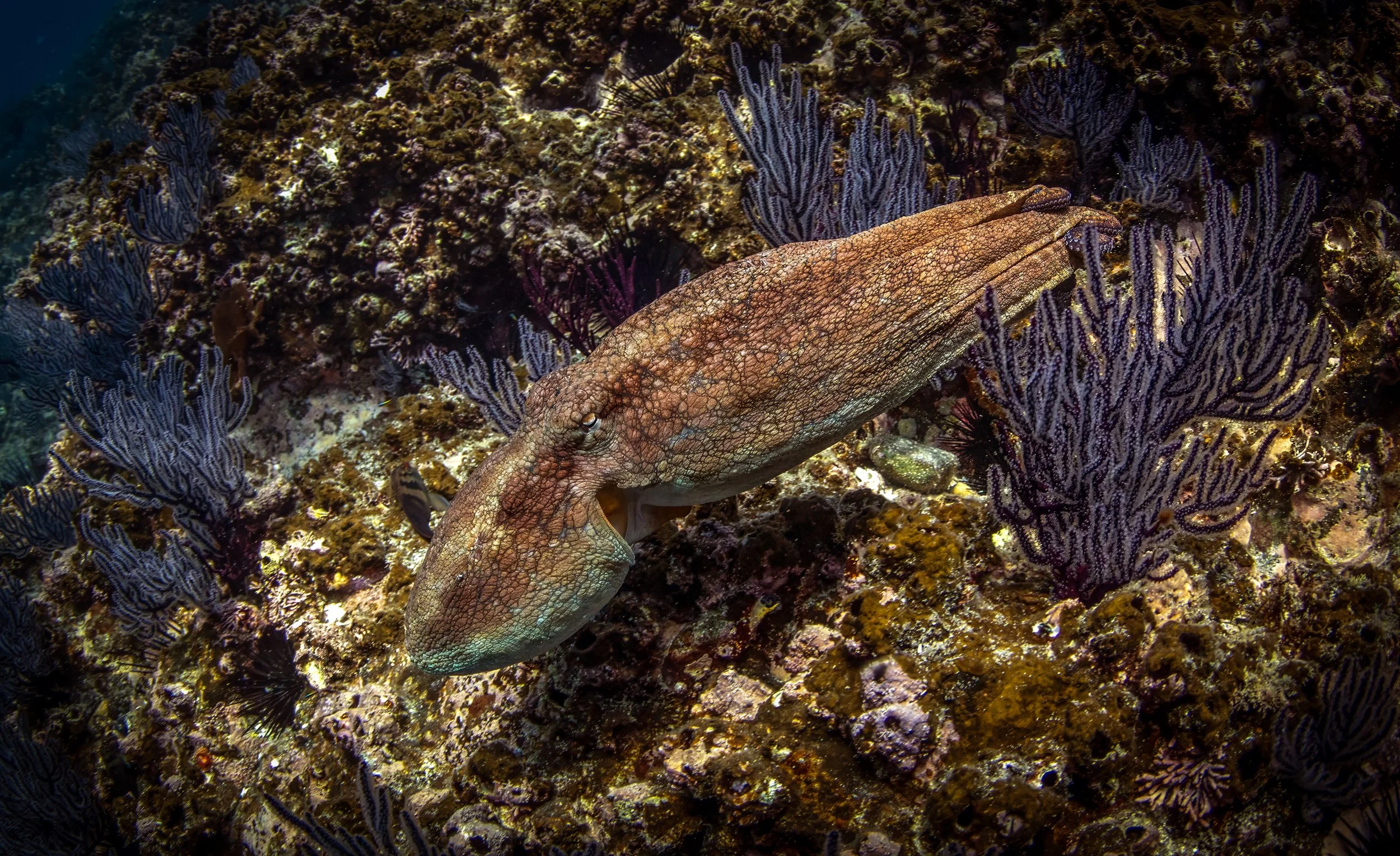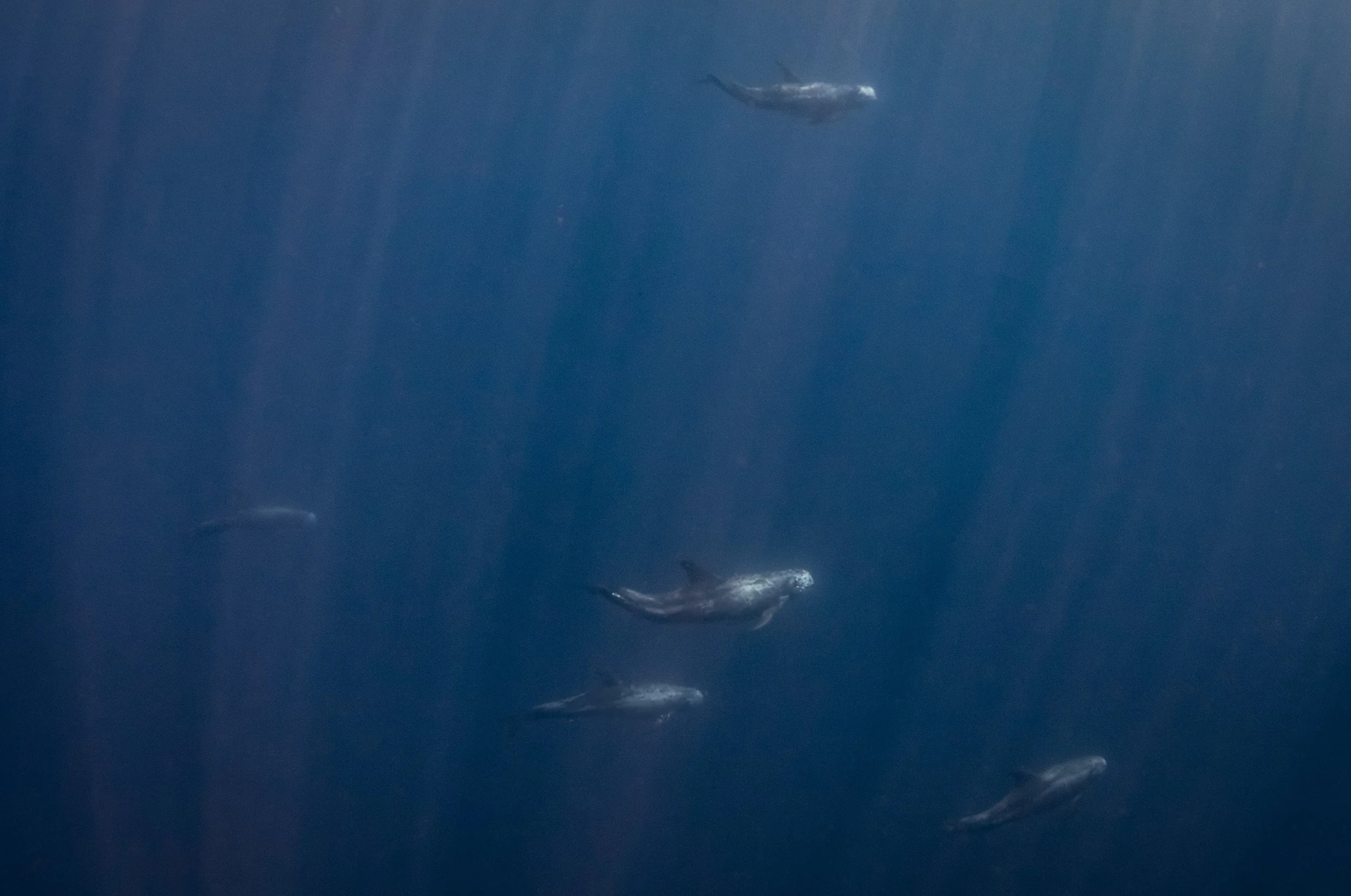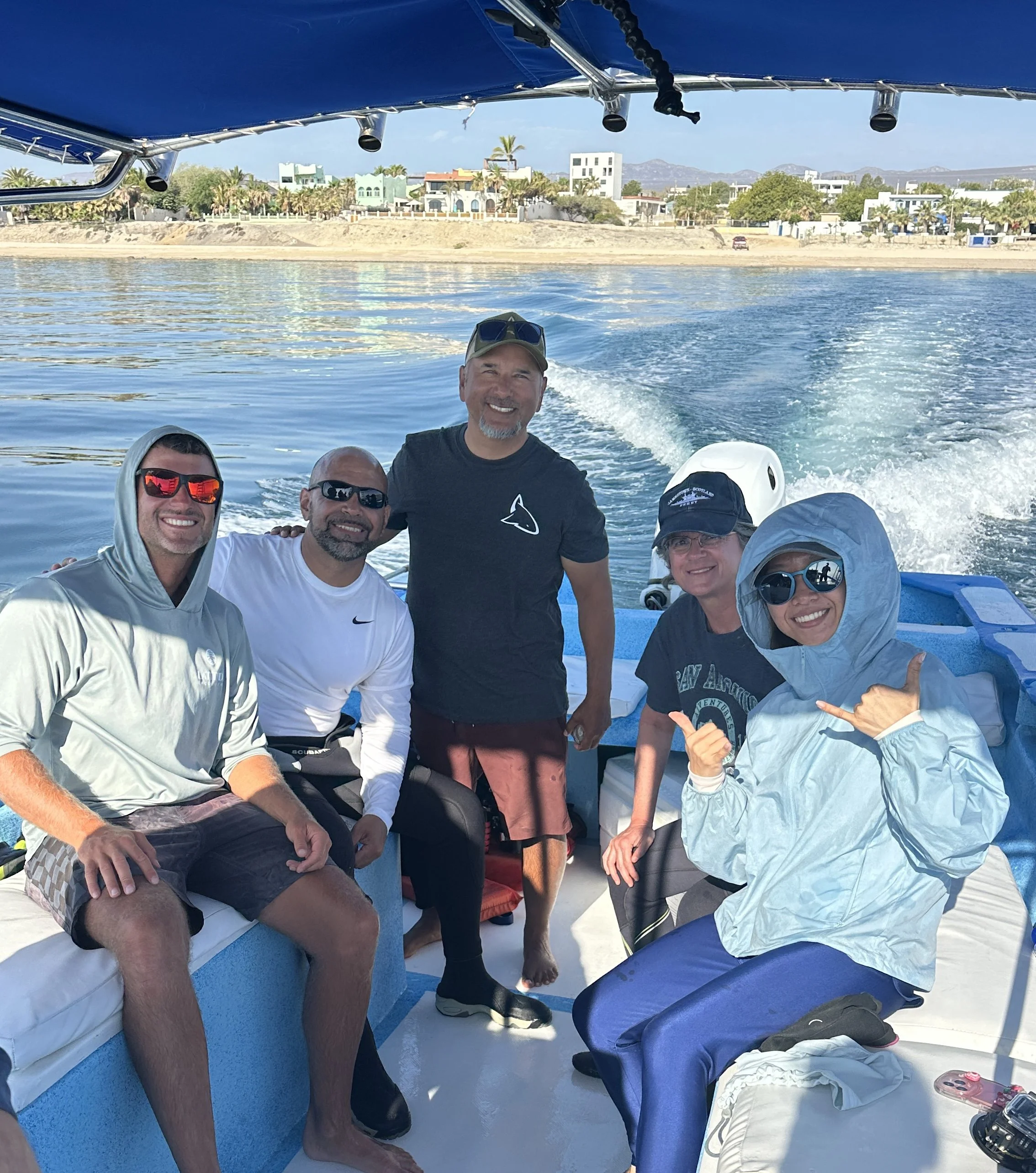Baja Wildlife Expedition Trip Report 2025
Trip # 5
June 8 - 15, 2025
June 9, 2025 – Day One.
New group. New week of diving. We left the dock at 7:00 AM, full of hope—but the open ocean had other plans. High winds are sweeping across the channel, so we’re forced to play it safe and stay inside the bay today.
The bay itself is stunning—flat calm, protected by the island, and full of life.
Everything beyond, though, looks blown out. Still, we’re here, we’ve got cameras, a boat full of snacks, and we’re going to make the most of the day.
8:00 AM. We’re on the hunt for a playful group of mobulas. We found a large fever of Mobulas (I just learned that word today), and gave it a shot, but they were skittish—tight formation, fast moving, not quite ready to have divers visit them today.
9:26 AM. And then… things turned around. We found the right group.
The mobula action was really, really good—it was a great session. They stayed near the surface, moving slowly, allowing us to get in close. We managed to snap some nice photos, and the footage is going to be really fun.
Savannah checking out the Baja locals. 1/400, f9, ISO 800
At one point, I just stopped shooting altogether, and followed along, watching them glide effortlessly through the water—beautiful little ocean angels. I do not do that often enough anymore. I would promise myself that I am gonna put the camera down to enjoy the animals more, but I know that is not gonna happen. I love shooting too much.
Today I photographed the mobulas with a shutter speed of 1/400 instead of 1/320. I think it is a much better number to work with, I noticed some of my close up mobulas were a bit soft, from previous sessions in May. Decided to make that change and I am much happier with the results.
1/400, f9, ISO 800
We pushed out farther to test the conditions, but the wind had other plans. Whitecaps were building fast. It became clear we wouldn’t get much more out of the open ocean today, so we turned around and headed back into the bay.
1:00 PM. We heard reports of dolphins in the area and went to check it out. Turned out to be a small pod of bottlenose. We watched them for a few minutes, but they weren’t in the mood to interact.
With the wind now pushing even into the bay and the surface getting choppy, we called it a day and headed in early.
Tomorrow’s is our day…and we’ll be ready.
June 10, 2025 – Day Two
6:00 AM
We’re heading out early, chasing opportunity before the wind shuts us down. A storm system is stirring up the sea, and forecasts say we’ll likely have to retreat early—so we’re making every minute count.
8:40 AM
Roughly 10 miles offshore, riding a rolling swell. The wind is slowly building, but conditions are still workable—and then, a gift…
Sperm whales.
We spotted distant blows and motored over quietly. I launched the drone to confirm the species and sure enough, it was a pod of five sperm whales, slowly cruising the surface. For a brief moment, they began to socialize—play fighting, nudging each other—it was absolutely incredible to capture on video.
I filmed them for a while, and just as the drone hit 35 minutes of flight time, I got the return-to-home warning. I rushed to bring it back. Cano and I tried to land it, but I reached too far and misjudged the approach—the drone clipped a canopy post and crashed onto the deck. Miraculously, nothing broke—not even the props. I’ll test it back at port to make sure it’s still functional. Either way, the footage is safe, and that alone makes the whole encounter worth it.
11:00 AM
To escape the rising south wind, we headed north and tucked in behind the island. The water flattened out again—calm enough to keep searching.
Soon, we found another pod of sperm whales, but this time they were scattered, clearly in hunting mode. A couple flukes lifted as they dove deep. Now the waiting game begins—sperm whales often dive for 45 minutes to an hour depending on depth.
We hung out and watched them for a short while. I was hoping they would group up and I could send the drone up (even though I was nervous about flying it after the crash), to film some socializing, but sadly they did not. So we left them to continue our search for orcas.
2:00 PM
We cruised to a known orca hotspot in the north. A friend’s group was already in the water—swimming with an oceanic manta. I’ve never seen one here, so we were ready in seconds. Unfortunately, the manta dropped out of sight before we could join the action.
As we searched, a huge pod of bottlenose dolphins arrived—leaping over the waves, full of energy. We approached and went for a jump.
The first jump was okay. The second, even better. But the third… was so good!
When I jumped in, I followed a few dolphins swimming ahead. As I kicked along, I began noticing more down below—dozens of them, deep beneath me. I started following, and as I did, the number kept growing. The dolphins rose up to the surface to breath. More and more dolphins began to arrive, joining the pod. They started slowing down just enough for me to catch up. Suddenly, I was surrounded—a wall of bottlenose dolphins stretched out in front of me. I snapped photo after photo. The visibility wasn’t great, but I didn’t care—this was the most bottlenose dolphins I had ever been around.
Then, something wild happened. The dolphins began to descend together. I turned to look behind me—even more dolphins had gathered, and they too started dropping down. It felt like the entire pod—more than a hundred strong—had converged and was now descending as one unit. It was absolutely mind-blowing to witness.
The video was amazing. (will upload that later).
It was an epic encounter. I swam among them, snapping one bad photo after another—but honestly, I didn’t care. I was so happy.
Bad proof of life photo.
Just being in that moment was everything.
I followed them as long as I could before hopping back onboard.
We finished with one more jump—and that was also a good jump.
A perfect way to wrap the day.
Thank you, Baja.
June 11, 2025 (Day Three)
We heard rumors of orcas spotted up near Cabo — but that’s not for us. That pod is too far north, well out of our range for the day.
Still, we know of at least eight different orca pods that travel through this region, so there’s a good chance one of the others could be nearby. With favorable conditions and calm seas, we set out with high hopes and a full day of searching ahead.
We spent the morning exploring the deep northern waters, scanning for wildlife. But as the hours passed, nothing surfaced. No dolphins, no orcas — just blue water and silence.
So we shifted gears and made our way to La Reyna to swim with the sea lions. But when we got close, we noticed a few boats off in the distance. Something was up.
Turns out, they had spotted an oceanic manta. We could actually see it gliding from the surface — massive, graceful, an ocean angel.
We geared up, ready to drop in, but had to wait our turn. Unfortunately, the group before us got a little too excited, and the manta dove deep and vanished. Just like that, gone.
We thought about heading to La Reyna, but it was too crowded — more than two boats and it loses its magic. It’s one of those spots best left for a quieter day.
With the wind picking up, we cruised over to Punta Norte for a snorkel — crystal-clear water, vibrant corals, and schools of little reef fish everywhere. I spent a few minutes trying to coax an octopus out of hiding. It wasn’t impressed… just flattened itself against the rock and pretended it wasn’t there. Zero photos of it.
Then we got word over the radio — one of our sister boats had found another manta nearby. We climbed back aboard and motored over. Got there in time for one quick jump. I managed to get a proof-of-life shot — just a butt photo, but hey, it’s official: I’ve seen a manta here. Now I just need a better one.
We lingered in the area a bit longer, hoping the orcas might still show up. But not today.
Now we’re heading in, a little salty, a little tired, and still hopeful for what tomorrow might bring.
June 12, 2025 (Day four)
We woke to more wind issues this morning. Right now, we’re headed south, hoping to try our luck in that direction before stronger south winds sweep in later today. The plan is to search as long as conditions allow—until we’re forced to retreat. And with that, the day begins.
Not long into the morning, we came across a humpback whale with a calf. We watched them for a while, taking it all in. For our friend Gerald, this was his first whale encounter ever—a powerful moment to witness. It’s always special helping someone experience their first ocean magic.
We continued pushing south, though the ride got rough. No whitecaps yet, but the swells were tight and close together, making for a pretty lumpy trip.
Farther down, we found another humpback—this one tail-slapping with energy. I launched the drone, though the wind made things tricky. Still, I managed to catch a couple tail slaps before bringing it back down—thankfully without a crash landing this time.
We motored out a bit farther, but eventually the wind and swell forced our retreat. The seas were building fast, so we turned back and hugged the coastline for the return trip.
On the way back, we made a quick stop at Puffer Cove to play with the locals. That dive never gets old—pufferfish are just too damn cute. I am seeing on social media more and more people visit this unique spot and a few people have even called it puffer cove. Think we started something here.
Such a cool spot.
Now we’re headed in. Whitecaps are everywhere, and there’s no real place left to work today.
Calling it a wrap.
Here’s hoping tomorrow gives us better weather and more time on the water.
Fingers crossed.
June 13, 2025 (Day 5)
Happy Friday the 13th — a special and lucky day.
And the luck showed up early: the weather finally broke. Calm seas and blue skies gave us the green light to explore wide.
We started off with a pod of bottlenose dolphins, swimming tightly together in a perfect little bay. It was the kind of scene that makes you want to turn off the engine and just listen to their breaths on the glassy surface. But the radio chatter from nearby captains kind of killed the mood.
So we motored on…
As we left the bay, two humpback whales greeted us — a mother and calf. The baby gave us a quick breach before they disappeared into the blue. A beautiful moment.
Then came a not-so-beautiful one: a massive fishing vessel, illegally operating far too close to shore. Captain Cano wasn’t happy. He grabbed his camera to film and document the violation. These boats are supposed to fish 20+ miles offshore. They don’t care.
Pirates.
We pushed out to 20+ miles offshore and hit gold — a superpod of pantropical spotted dolphins. These dolphins can be playful, so we took our chances and jumped in.
And man, it was worth it.
The dolphins were full of energy and curiosity, swimming close, circling around us. We had incredible, up-close encounters. As they moved off, we noticed a large school of yellowfin tuna below. The dolphins were either following the tuna… or vice versa.
Then, from the corner of my vision — a five-foot silky shark glided up right next to me and Gerry. We both got some great proof-of-life shots.
That jump was fire.
We got back in for another round, but this time the dolphins were gone. Vanished into the deep. We started swimming back to the boat… and out of nowhere, the dolphins returned, rising from the depths like ghosts. They circled us again, fast and fluid.
We did a few more jumps before leaving them be. Just us and one of our sister boats were out there. A spotter plane flew over and circled, then peeled off — but a few boats followed in its wake and soon arrived.
We gave the dolphins one last drop, then moved on, leaving the newcomers to the scene.
With perfect weather, we were able to cover a lot of water. We headed north toward the orca grounds — an area that’s been rich with activity this season.
Later, we stopped at La Reyna for a snorkel. The water was stunning. While exploring, we came across a massive male sea lion keeping watch over his harem. He was huge, but calm. Blew bubbles at me once. Real gentleman.
In the shallows, I found an octopus and spent some time photographing it. At first it was shy, doing its best rock impression, but eventually it relaxed and began crawling across the reef. I wanted some swimming shots of the octopus.
I waited, watched, and finally got the swimming shots I was hoping for. Fingers crossed they turned out.
We wrapped up at La Reyna and motored over to “Orcalandia” — the orca hotspot. No orcas, but we did find another pod of spotted dolphins actively hunting. It turned into an airshow: dolphins chasing bait on the surface, frigate birds and boobies diving from above, and even a sailfish slashing through the mix underwater.
The baitfish were too scattered to justify a jump, but it was still an epic scene.
Then came the call: sperm whales reported nearby.
We changed course and sure enough, we found them — a pod of 20+ sperm whales, unusually close to shore in the bay. I sent up the drone and captured footage of them swimming together. We tracked them for a bit, and then let them be.
A perfect, peaceful end to a long and amazing day at sea.
The search for orcas continues…
June 14, 2025 (Day 6)
Final day. Crunch time. We headed out into a glassy, perfect ocean — calm seas, beautiful light. Of course, the forecast said the wind might pick up later, but we didn’t know how much time we had. So we pushed out, planning to go as far as we could, chasing whatever magic the sea had left for us.
11:00 AM. We’ve just spent the last two hours with a massive pod of Risso’s dolphins!
They were shy — no close passes — but it didn’t matter. Just being in the water with them was an experience. Powerful animals, slow and ghostlike, their presence alone made the morning feel special. Risso encounters are rarer than orcas.
I had some great encounters with the rissos. They have not come in super close, but I did have some juvenile rissos hang around watching me from a distance daring themselves to try and swim as close as they dared to me.
Best proof of life photo I managed of this species. Super happy I was even able to capture this image. They were so shy!
At one point the rissos decided to take a nap and we sleeping on the surface, logging. I sent the drone up to capture it. It was so good.
While the drone was in the air I captured some extremely rare behavior… risso dolphins and bottlenose dolphins mating! It turns out in captivity their are hybrids from these species.
I get that this happens in captivity where boredom might create the opportunity these dolphins need to be curious and mate. Super wild that we got to see this behavior in the wild.
And beneath the dolphins? Silky sharks. Lots of them. Curious, and coming in close. We had several solid passes — Love these sharks.
Between the dolphins and the sharks, the ocean gave us a full show.
The water held up beautifully. Light, calm, and clear. So far, the day has been incredible.
12:00 PM. We’ve left the Risso’s behind for one last push to find orcas. But honestly? Even if we don’t find them, this morning alone was a perfect way to close the trip. Still, we’ve got a few more hours on the water — and you never know what’s coming next.
Later in the day
We came across a pair of mating olive Ridley sea turtles in ideal conditions. We stopped to film for a bit and observe. The male was doing this head-shaking behavior during mating — I wonder if it’s part of the ritual, or if it was directed at us. It would be interesting to see the same scene with another male nearby to understand the full behavior.
At the end of their mating session the male turtle, came over to look at itself in my dome port. Such cool looking animals.
The weather has stayed in our favor, so we continued pushing south, still holding out hope for orcas.
3:30 PM. Our last swim of the trip: we stopped at a reef near Ceralvo Island and got in the water with a massive male sea lion. He was just floating at the surface, relaxed and regal, completely unbothered by our presence. A beautiful, peaceful end to a great day.
The orcas didn’t show this week. Last week, they were around for four days straight, hunting turtles. This week, they’re off doing orca things somewhere else. That’s the wild for you — no guarantees.
But what a week.
Sperm whales on two different days.
Superpods of dolphins.
Sharks.
Risso’s dolphins this morning.
And today, turtles and sea lions.
Baja delivered again — not with everything we hoped for, but with more than enough to make it unforgettable. This week just reinforced what I already know:
This place is wild. Raw. Beautiful.
And truly one of the most epic wildlife destinations on Earth.
Thanks to my friends who joined us on this trip. Sending big hugs your way! Hunter sorry you missed the group photo.
Wildlife we have encountered this week:
Mobula rays
Sperm whales
Bottlenose dolphins
Olive Ridley sea turtle (mating)
Jumping striped marlin
Jumping thresher shark
Bottlenose dolphins
Oceanic manta ray
Humpback whales
Pantropical spotted dolphins
Yellowfin tuna
Silky sharks
Sailfish (from the boat)
Sealions
Octopus









